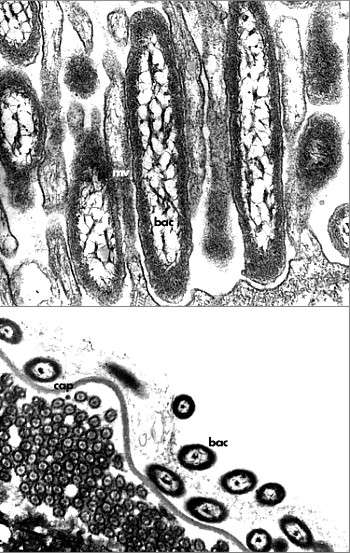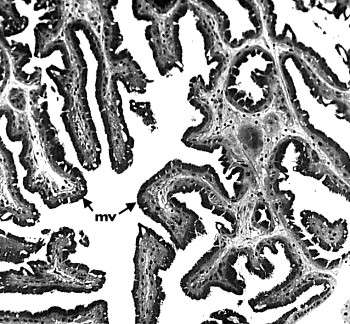

Bacteria in nudibranchs
PHOTO
TOP: Transmission electron micrograph showing the arrangement of bacteria in between the microvilli of the vestibular gland of Dendrodoris nigra in longitudinal section. Abbreviations: bac: bacteria; mv: microvilli. MIDDLE: Transmisson electron micrograph showing the bacteria within the egg mass along the egg capsule. Abbreviations: bac: bacteria; cap: capsule; ci: cilia. LOWER: TEM showing a cross section (2.5 µm) through the vestibular gland. Abbreviations: mv: microvilli.
PHOTOS: Annette Klussmann-Kolb.
Dendrodoris nigra(Stimpson, 1855) is a widespread Indo-West Pacific nudibranch mollusc of the family Dendrodorididae. The genus is notable because of its highly glandular anterior digestive system and lack of radula. The species feeds on non-reticulated sponges of the genera Halichondria and Tedania.
The vestibular gland and egg masses of Dendrodoris nigra were investigated histologically and ultrastructurally. The vestibular gland is attached to the distal oviduct of the sea slug and its function is currently unknown. This gland is thought to be related to reproduction, possibly to
egg mass formation. Detailed investigation of the gland revealed the presence of symbiotic bacteria aligned between the microvilli of the glandular cells. Symbiotic bacteria related to reproduction has not been previously reported for gastropods.
Identical looking bacteria were also found in the mucous layers of its egg masses. The number of bacteria in the egg mass increased during development. These bacteria are not external contaminants but are actively reproducing and are stored within the nudibranch for an apparently functional purpose. We have proposed several hypotheses about their function:
1. the bacteria play a role in the breakdown of the egg mass mucous coating and the egg capsule
2. the bacteria protect the egg mass from colonization by other organisms (e.g. fungi, protozoans)
3. the bacteria may function as a nutritional source for the larvae
4. the bacteria are highly specialised and may be passed from generation to generation.
Further studies are necessary to classify the bacteria and to investigate their role in the life history of the sea slug.
Reference: Klussmann-Kolb, A. & Brodie, G. (1999) Internal storage and production of symbiotic bacteria in the reproductive system of a tropical marine gastropod. Mar. Biol. 133(3): 443-447.
Annette Klussmann-Kolb
Ruhr-Universität Bochum
Spezielle Zoologie
ND05/755
44780 Bochum
GERMANY
Annette.D.Klussmann-Kolb@ruhr-uni-bochum.de
Gilianne D. Brodie
Dept.of Marine Biology
James Cook University,
Townsville 4811,
AUSTRALIA
gilianne.brodie@jcu.edu.au
Klussmann-Kolb, A.D. & Brodie, G.D., 1999 (July 30) Bacteria in nudibranchs. [In] Sea Slug Forum. Australian Museum, Sydney. Available from http://www.seaslugforum.net/factsheet/bacteria
Related messages
-
Bacterial/archaeal symbionts
From: Elissa Murphy, March 13, 2001 -
Endosymbiotic bacteria in Nudibranchs
From: Joseph Potvin, March 3, 2000 -
Bacteria in nudibranchs
From: A. Klussmann-Kolb & G. Brodie, July 30, 1999
